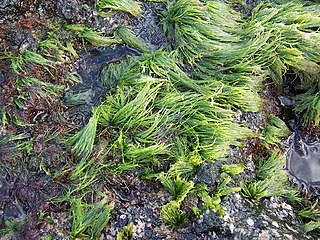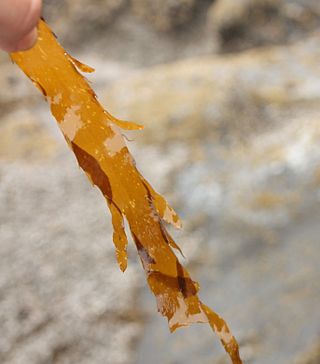
Chlorophyta is a taxon of green algae informally called chlorophytes. The name is used in two very different senses, so care is needed to determine the use by a particular author. In older classification systems, it is a highly paraphyletic group of all the green algae within the green plants (Viridiplantae) and thus includes about 7,000 species of mostly aquatic photosynthetic eukaryotic organisms. In newer classifications, it is the sister clade of the streptophytes/charophytes. The clade Streptophyta consists of the Charophyta in which the Embryophyta emerged. In this latter sense the Chlorophyta includes only about 4,300 species. About 90% of all known species live in freshwater. Like the land plants, green algae contain chlorophyll a and chlorophyll b and store food as starch in their plastids.

Pedinellales is a group of single-celled algae found in both marine environments and freshwater.

AlgaeBase is a global species database of information on all groups of algae, both marine and freshwater, as well as sea-grass.

Ectocarpales is a very large order in the brown algae. The order includes families with pseudoparenchymatous (Splachnidiaceae) or true parenchymatous (Scytosiphonaceae) tissue. Pseudoparenchymatous refers to a filamentous alga with cells packed very close together to give an appearance of parenchymatous tissue, the latter being composed of cells which can truly divide in three dimensions, unusual among the algae. Filamentous algae are composed of cells that divide along a single plane, allowing only elongation to form filaments of one or more rows of cells. Algae that can divide in two planes can form sheet-like thalli or bodies. Cells that can divide in a third plane potentially allow for the organism to develop a more complex body plan, and diversification of body plans into an erect thallus of some sort and a holdfast for attaching the upright portion to the substrate.

Eustigmatophytes are a small group of eukaryotic forms of algae that includes marine, freshwater and soil-living species.

Chaetophorales is an order of green algae in the class Chlorophyceae.

Caulerpaceae is a family of green algae in the order Bryopsidales.

Chaetomorpha is a genus of green algae in the family Cladophoraceae. Members of this genus may be referred to by the common name sea emerald.
Prasinococcus is a monotypic genus of green algae, containing the only species Prasinococcus capsulatus, in the monotypic family Prasinococcaceae. This unicellular algal species was discovered in 1990 in the West Pacific Ocean and has characteristic reproduction methods as well as an interesting and potentially exploitable morphology. This is the only species in the genus, though various strains exist, for example URI 266G is the Atlantic clone.
Pycnococcus is a genus of green algae in the family Pycnococcaceae.

Sykidion is a genus of green algae. Pseudoneochloris is a synonym of this genus. As of March 2022, Sykidion was the only genus in the family Sykidiacaeae, which was the only family in the order Sykidiales.

Dictyochophyceae sensu lato is a photosynthetic lineage of heterokont algae.

Kappaphycus is a genus of red algae. Species are distributed in the waters of East Africa, Indonesia, Malaysia, Hainan Island, the Philippines, and Micronesia.

Desmarestiaceae is a family of brown algae, one of two families in the order Desmarestiales. The family gets its name from the genus Desmarestia, which is named after the French zoologist Anselme Gaëtan Desmarest (1784-1838).
Chrysomerophyceae is a monotypic class of photosynthetic heterokont eukaryotes.

Picophagea, also known as Synchromophyceae, is a class of photosynthetic stramenopiles. The chloroplast of the Synchromophyceae are surrounded by two membranes and arranged in a way where they share the outer pair of membranes. The entire chloroplast complex is surrounded by an additional two outer membranes.

Michael Dominic Richard Guiry, is an Irish botanist, who specialises in phycology (algae). See for example the articles. He is the founder and director of the algal database, AlgaeBase.













